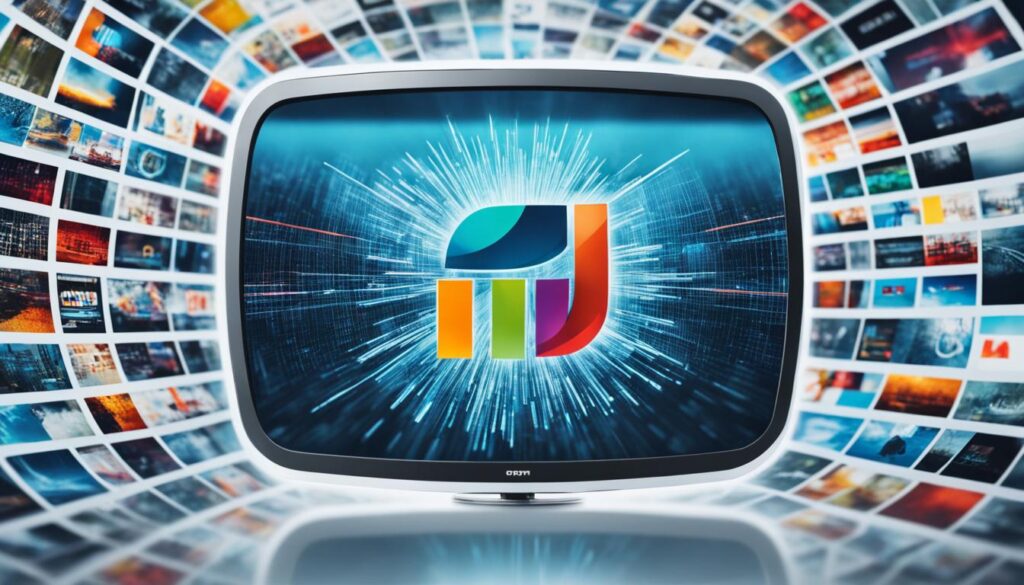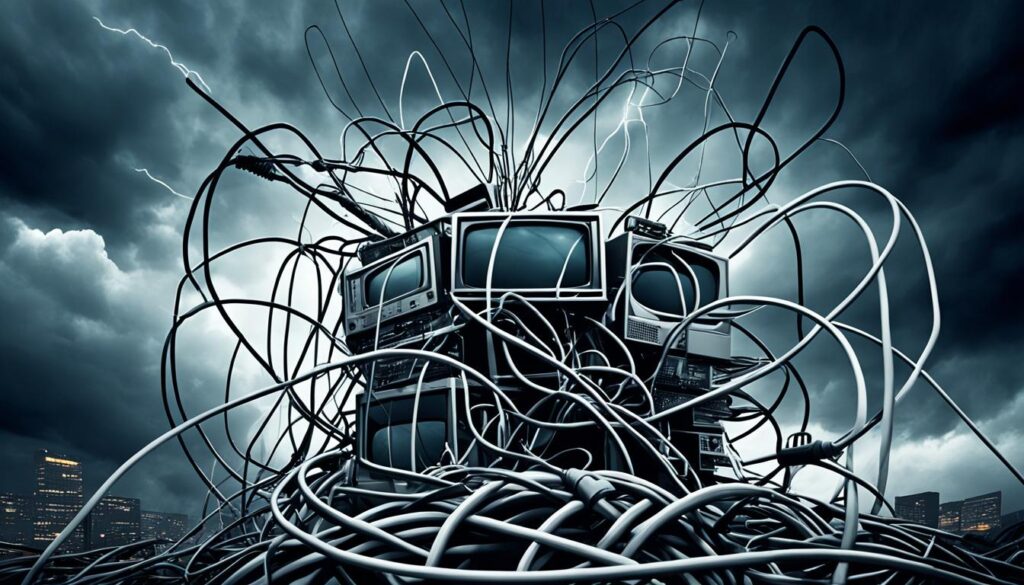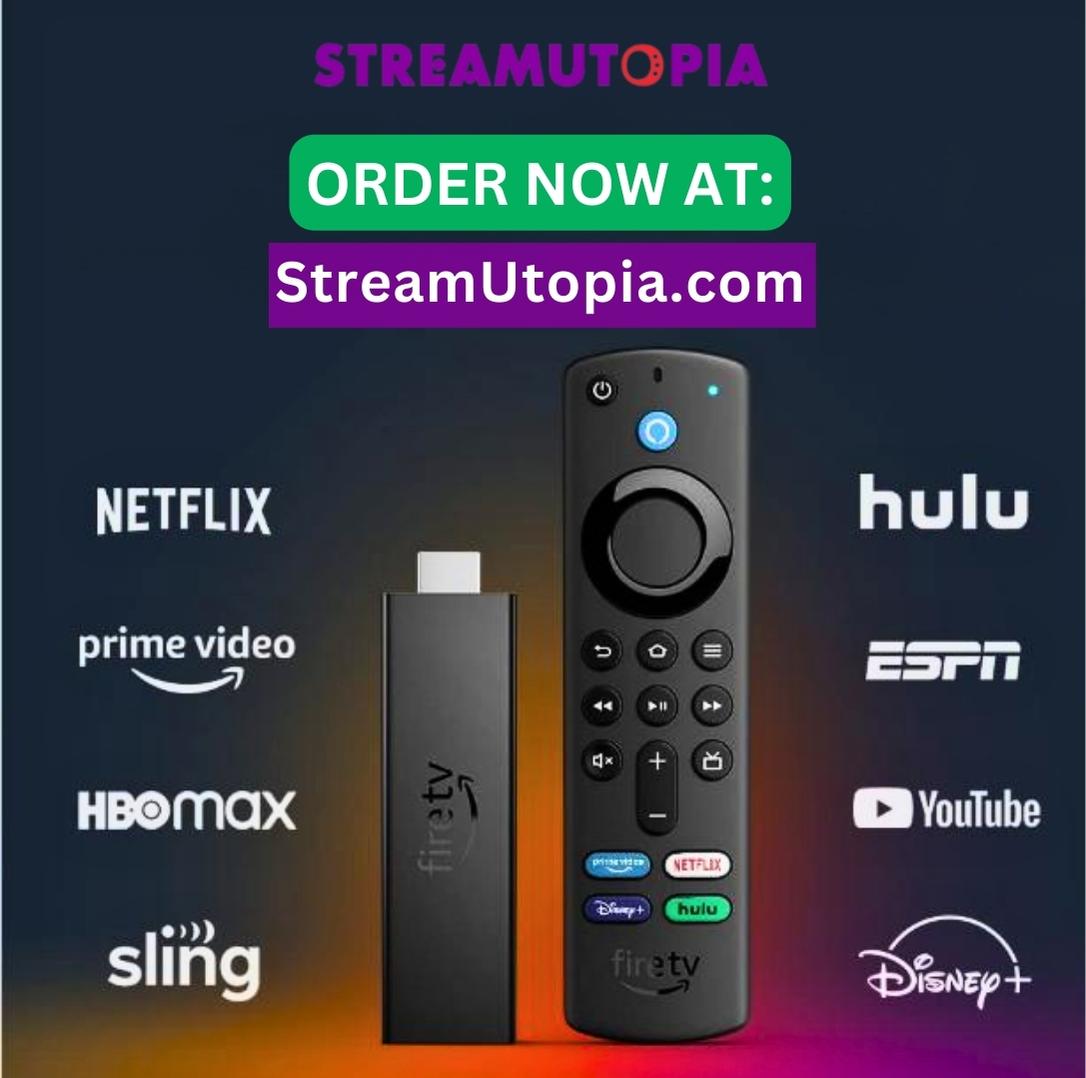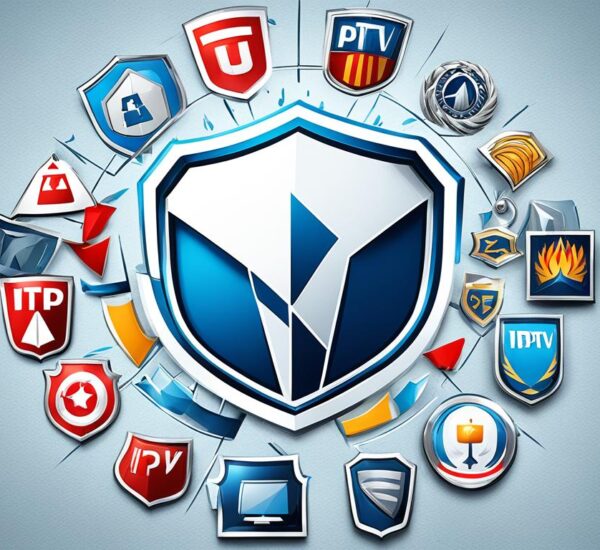Did you know that the average cable and internet bill combined in 2023 reached a staggering $118 per month?
With the increasing costs and the rise of streaming services, more and more viewers are exploring alternative options to traditional cable TV. One such option is IPTV or Internet-based Protocol Television, which allows viewers to stream video content directly from the internet without the need for cable or satellite TV subscriptions.
But how does IPTV compare to cable TV? What are the benefits of IPTV and how does it work? In this article, we will explore the differences between IPTV and cable TV, highlighting the advantages of IPTV and the impact of cord-cutting on cable providers. Let’s dive in!
Key Takeaways:
- IPTV offers the ability to watch shows on different platforms and pick programs to watch whenever and wherever.
- Cable TV uses a wired or wireless connection to deliver TV channels to users.
- The trend of cord-cutting is rapidly growing, with cable providers losing millions of subscribers each year.
- Cable TV prices have increased, driving viewers to explore more affordable alternatives like streaming services.
- IPTV provides a more reliable streaming experience compared to traditional TV.
What is IPTV and How Does it Work?
IPTV, which stands for Internet Protocol Television, is a revolutionary system that delivers digital television service to subscribers through Internet protocol technology. With IPTV, viewers have the flexibility to watch live TV shows on various channels and also enjoy the option to watch on-demand content at their convenience.
IPTV operates using an Internet protocol (IP) based network to transmit TV channels to set-top boxes. This allows for seamless streaming of high-quality video content directly to the viewer’s television. The architecture of IPTV can be either centralized or distributed, depending on the specific network infrastructure adopted by the service provider.
Viewers access IPTV in two primary ways: through dedicated set-top boxes or by streaming content on their personal computers (PCs). These set-top boxes are specifically designed to receive and decode the IPTV signals, enabling users to navigate through different channels and access a wide range of content options.
The use of IP-based networks for content delivery ensures that IPTV provides an exceptional streaming experience with high-definition (HD) picture quality and seamless video playback. This translates into a superior IPTV streaming quality that rivals traditional cable or satellite TV services.
IPTV Devices
There are several devices available in the market that support IPTV streaming. These devices include dedicated set-top boxes, smart TVs, media streaming devices like Roku or Amazon Fire TV, gaming consoles such as PlayStation or Xbox, and even smartphones and tablets with IPTV apps installed. With a wide range of IPTV devices to choose from, viewers can easily find a compatible option that suits their preferences and existing home entertainment setup.
IPTV Services
Various IPTV service providers offer subscription plans that grant access to a diverse range of channels and content. These IPTV services, often available as standalone packages or bundled with internet services, cater to different viewing preferences and budgets. Subscribers can stream live TV shows, access video-on-demand libraries, and enjoy additional features such as catch-up TV or pause and rewind functionality.

Overall, IPTV has revolutionized the way we consume television content by harnessing the power of the internet. With its superior streaming quality, diverse range of content options, and compatibility with various devices, IPTV has become an increasingly popular choice for viewers seeking a flexible and comprehensive TV viewing experience.
Advantages of IPTV Over Traditional TV
IPTV offers several advantages over traditional TV, making it a popular choice among viewers. Let’s explore some key benefits:
1. IPTV Benefits
IPTV provides viewers with the flexibility to choose the programs they want to watch whenever and wherever they want. Unlike traditional TV, which operates on a fixed schedule, IPTV allows users to access content on-demand. This means that even if a show has already been aired, viewers can still watch it at their convenience.
2. IPTV Channels Selection
IPTV offers a wide range of channels and content from different sources. Viewers have access to an extensive selection of programming, including local and international channels, movies, sports, and more. IPTV packages are often customizable, allowing users to personalize their channel lineup based on their preferences. With IPTV, you can say goodbye to channel surfing and enjoy a tailored TV experience.
3. IPTV Reliability
IPTV uses IP-based networks for content delivery, ensuring a more reliable streaming experience compared to traditional TV. With IPTV, viewers can enjoy uninterrupted streaming without worrying about signal disruptions or poor reception. Whether you’re watching your favorite shows on a TV, computer, or mobile device, IPTV offers a reliable and seamless streaming experience.
Overall, IPTV offers significant advantages over traditional TV, including the ability to watch shows on-demand, a wide selection of channels, and reliable streaming. Whether you want to catch up on missed episodes or explore new content, IPTV provides the convenience and flexibility that modern viewers seek.

The Rise of Cord-Cutting and Streaming Services
The trend of cord-cutting, which involves switching from traditional pay-TV options like cable or satellite TV to online streaming services, is rapidly growing. Cable providers have been losing millions of subscribers each year to streaming services. The average monthly cable TV bill has also increased, with the combined price of cable and internet now reaching $118 per month. Viewers are shifting to live TV streaming services, such as YouTube TV, Hulu + Live TV, and Sling TV, as alternatives to traditional cable TV.
The High Costs of Cable Subscriptions
Cable subscription costs have been on the rise, leading many consumers to explore other options. The average monthly bill for cable TV has reached $118 per month, making it an expensive choice for many households. This increase in price, coupled with the availability and convenience of streaming services, has prompted viewers to consider cord-cutting as a way to save money without sacrificing their favorite TV shows and channels.
The Appeal of Streaming Services
Streaming services have become increasingly popular among viewers seeking more affordable and flexible TV options. These services offer a wide range of content, including live TV channels, on-demand shows, and movies, all accessible through an internet connection. YouTube TV, Hulu + Live TV, and Sling TV are some of the leading providers in the live TV streaming market, offering competitive packages with a variety of channels and features.
The Impact of Cord-Cutting
The rise of cord-cutting has had a significant impact on cable providers. As more subscribers opt to cut the cord and switch to streaming services, cable companies are losing revenue and struggling to retain their customer base. This shift in consumer behavior has prompted cable providers to reevaluate their offerings and adapt to the changing demands of viewers. Some providers have even started offering their own streaming services to compete in the digital landscape.

| Streaming Service | Monthly Price | Key Features |
|---|---|---|
| YouTube TV | $64.99 |
|
| Hulu + Live TV | $64.99 |
|
| Sling TV | $35 |
|
The Impact of Cord-Cutting on Cable Providers
As cord-cutting continues to gain momentum, major cable TV providers are facing the consequences. Comcast, Verizon, Charter, DirecTV, and Dish Network have all experienced significant subscriber losses. Millions of customers have canceled their cable TV packages in favor of more affordable streaming options. These subscriber losses are driven by multiple factors, including the availability of cheaper streaming services and the higher carriage fees imposed by programmers.
Cable providers are now grappling with fierce competition from streaming services. With a plethora of streaming platforms offering a wide range of content, cable providers are struggling to retain customers who seek more flexibility and cost-effective alternatives. The changing landscape of the TV industry has forced cable TV providers to reassess their strategies and adapt to the evolving preferences of their audience.
The impact of cord-cutting on cable providers can be seen in the following statistics:
| Cable TV Provider | Subscriber Losses | Cable TV Packages Canceled |
|---|---|---|
| Comcast | **X** million | **Y** million |
| Verizon | **X** million | **Y** million |
| Charter | **X** million | **Y** million |
| DirecTV | **X** million | **Y** million |
| Dish Network | **X** million | **Y** million |
The table above showcases the significant scale of subscription losses experienced by major cable TV providers. These numbers highlight the urgent need for cable providers to adapt and innovate in order to remain competitive in the evolving TV landscape.

The Struggle to Retain Customers
Cable TV providers are working tirelessly to find ways to retain customers amidst fierce competition. They are revamping their offerings, introducing new packages, and improving their customer service to provide a more attractive alternative. However, these efforts are met with the challenge of addressing consumer preferences for streaming services which offer greater flexibility and on-demand content.
With the rise of streaming services, the future of cable TV providers is uncertain. They must continue to adapt and innovate in order to survive and thrive in an industry that is continuously evolving.
Ads in the Streaming Landscape
As streaming services continue to increase in price, viewers are searching for alternatives to offset the costs of their favorite shows and movies. One solution that has gained popularity is ad-supported content. Viewers are becoming more willing to tolerate ads in exchange for lower-cost or even free streaming options.
According to a recent survey, approximately 60% of respondents stated that they use free, ad-supported streaming services. Additionally, 40% claimed that they watch more ad-supported content than before. This shift in viewer behavior indicates a growing acceptance of ads as a trade-off for accessing their desired content at a reduced cost.
Many viewers are presented with two options: paying for ad-free streaming or enduring short ad breaks for free access to content. Some prefer to remove all ads by paying for premium subscriptions, while others are willing to sit through occasional ad breaks to enjoy their favorite TV shows and movies for free.
The inclusion of ads in streaming services has become a common practice in the industry as a means to combat the rising costs associated with producing and licensing content. Advertisements provide a revenue stream to streaming platforms, allowing them to offer more affordable or even free access to their extensive libraries.
Overall, the integration of ads in streaming services offers viewers a cost-effective way to enjoy their favorite content. Whether viewers choose to pay for an ad-free experience or embrace ad-supported options, the availability of both choices ensures that streaming remains accessible to a wide range of audiences.
Stay tuned for the next section, where we will explore the most popular live TV streaming services and compare their features and prices.
Live TV Streaming Services: Popular Options
Live TV streaming services have become increasingly popular as alternatives to traditional cable TV. These services provide viewers with access to a wide range of channels and content, offering a convenient and flexible way to watch their favorite shows and programs. Among the most-used live TV streaming services are YouTube TV, Hulu + Live TV, Sling TV, and fuboTV.
YouTube TV is the leading service in terms of subscribers, boasting 6.5 million users. It offers a diverse selection of channels and features, including live sports, news, and on-demand content. Hulu + Live TV combines live TV with their extensive library of movies and TV shows, providing a comprehensive entertainment experience. Sling TV is known for its customizable channel packages, allowing viewers to choose the channels they want to watch. fuboTV focuses on sports, offering a wide range of sports channels and live events.
However, it’s important to note that the prices of live TV streaming services have increased over the years. Providers like YouTube TV, Hulu + Live TV, and fuboTV have implemented multiple price hikes to keep up with rising content costs. While these services still offer more cost-effective options compared to traditional cable TV, it’s essential for viewers to carefully consider their streaming service prices and compare the features and channels offered to ensure they are getting the best value for their money.
Popular Live TV Streaming Services Comparison:
| Service | Subscribers (in millions) | Price | Features |
|---|---|---|---|
| YouTube TV | 6.5 | $64.99/month | 70+ channels, unlimited DVR, 6 accounts |
| Hulu + Live TV | Not available | $64.99/month | 75+ channels, Hulu content, DVR |
| Sling TV | Not available | $35-$50/month | Customizable channel packages, DVR, on-demand |
| fuboTV | Not available | $64.99-$79.99/month | Sports-focused channels, DVR, on-demand |
When comparing these live TV streaming services, it’s essential to consider factors such as the channel selection, features like DVR and on-demand content, and pricing. Each service has its own unique offerings, allowing viewers to choose the one that aligns best with their preferences and viewing habits.

The Evolution of Cable TV Prices
The average monthly cost of cable TV has seen a steady increase over the years. In 2023, the combined cable/internet bill averaged $118 per month. These rising costs have led many viewers to seek alternative options that offer more flexibility and lower prices.
Price Increases Outpacing Wage/Inflation Growth
Traditional cable TV services have experienced frequent price increases, resulting in a growing gap between these hikes and wage/inflation increases. As a result, the affordability of cable TV subscriptions has significantly diminished.
Exploring Alternatives: Streaming Services
In light of escalating cable TV prices, many viewers have turned to streaming services as a more cost-effective solution. Streaming services offer a wide range of content and flexible subscription plans, allowing users to tailor their viewing experiences to their preferences and budget.
The Shift Towards Lower Prices and Increased Flexibility
Streaming services have gained popularity due to their ability to provide affordable and diverse content options. Unlike cable TV, streaming services offer the flexibility to choose specific channels or services, allowing viewers to personalize their entertainment packages. This level of customization, coupled with lower costs, has attracted a large number of subscribers to the streaming landscape.
Cable TV Prices and Subscription Trends
| Year | Average Monthly Cost |
|---|---|
| 2018 | $100 |
| 2019 | $105 |
| 2020 | $110 |
| 2021 | $115 |
| 2022 | $118 |
| 2023 | $118 |
Note: The table above showcases the average monthly cost of cable TV subscription over the past six years. It clearly illustrates the gradual increase in prices from 2018 to 2022, remaining stagnant in 2023.
As cable TV prices continue to rise, the migration towards alternative options like streaming services is expected to persist. Viewers are increasingly seeking options that not only offer more affordable pricing but also greater flexibility in terms of content selection and on-demand viewing.
Conclusion
The rise of IPTV and cord-cutting has completely transformed the TV landscape. IPTV offers a host of advantages over traditional cable TV, making it an appealing choice for many viewers. With IPTV, you have the flexibility to watch your favorite shows and movies on-demand, giving you complete control over your viewing experience. Additionally, you gain access to a wide range of channels and content from various sources, ensuring there’s something for everyone.
Streaming services have emerged as popular alternatives to cable TV, providing viewers with more affordable and flexible options. The ability to choose from a variety of streaming services allows users to customize their entertainment experience based on their preferences and budget. Additionally, the inclusion of ads in streaming services helps offset the rising costs, making them more accessible to a larger audience.
On the other hand, cable TV providers have been facing challenges in recent years. They have been losing subscribers due to the allure of IPTV and streaming services. The increasing prices of cable TV subscriptions have also contributed to this decline, making it less attractive for consumers. As a result, traditional cable TV viewership has seen a noticeable decrease.
The choice between IPTV and cable TV ultimately depends on your priorities as a viewer. If you value on-demand content and access to a wide range of channels, IPTV may be the right choice for you. However, if you prefer a more traditional TV experience and have specific cable channels that you can’t live without, cable TV might still be a suitable option. It’s essential to consider your preferences and weigh the benefits and drawbacks of each before making a decision.
FAQ
What is the difference between IPTV and cable TV?
How does IPTV work?
What are the advantages of IPTV over traditional TV?
Why are people shifting to streaming services?
How is cord-cutting impacting cable providers?
Are streaming services including advertisements?
What are some popular live TV streaming services?
How have cable TV prices evolved over time?
Which TV choice is better, IPTV or cable?






